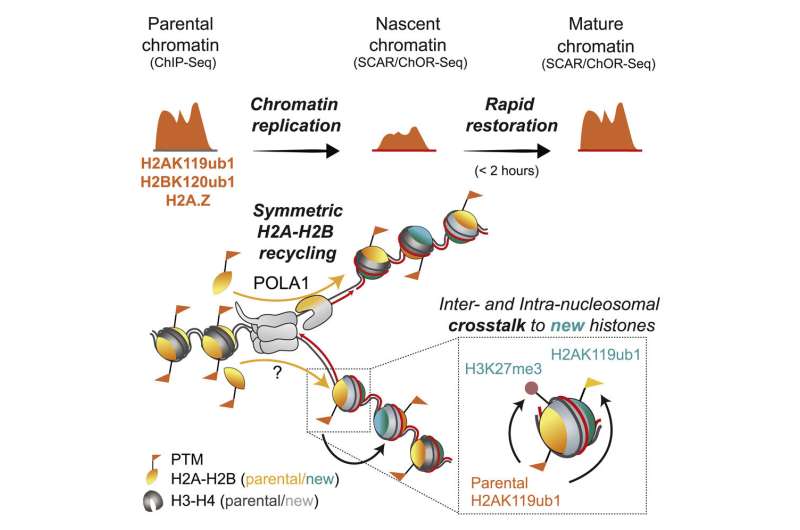This article has been reviewed according to Science X's editorial process and policies. Editors have highlighted the following attributes while ensuring the content's credibility:
fact-checked
peer-reviewed publication
trusted source
proofread
Previously unknown cell mechanism could help counter cancer and aging

As time passes and we get older, many cells need to replenish themselves. They do so by dividing into new cells: Heart cells, skin cells and so on.
But when cells continue to divide and make new cells, they lose some of the information from their mother cell. In the end, they may have lost so much of the original information that the structure of the genome deteriorates, which makes the new cells less good at their job. They may even do unwarranted thing such as divide too much and become cancer cells.
Because cells lose important information over time, scientists want to understand how cells copy their information. If science did understand that, we would be able to make cells preserve themselves much better than we do now and be able to slow down aging and perhaps even counteract cancer.
In a new study published in Cell, researchers from the University of Copenhagen discovered an unknown mechanism of how cells 'remember' their identity when they divide—the cells so-called epigenetic memory.
"Once we fully understand this mechanism, it could help counteract cancer and aging. It is a part of the amazingly complex network acting to maintain function of each cell in our body. If we disrupt this mechanism we could make cells forget their identity and this could help turning them into other cell types which is useful in regenerative medicine," says corresponding author and Professor Anja Groth at the Novo Nordisk Foundation Center for Protein Research.
"Now that we have discovered this new level of regulation, the next step is to understand it in detail and describe its full physiological role. Because before targeting or changing any cellular process, we first need to understand molecularly how it works. Here, we are laying the first bricks on the road to modulate how cells copy the epigenetic landscape. Huge efforts are already being invested in epigenome editing and epigenetic rejuvenation is an emerging hot topic, and our work will feed into these ongoing developments," says Anja Groth.
The book of life
In technical terms, the new mechanism the team discovered is called "H2A-H2B mediated epigenetic memory." To understand what the mechanism does, imagine our genome as a recipe book. The book describes all recipes for cell types, organs and tissues.
As described initially, it is very important that each cell type use a correct combination of information—i.e. recipes. Because if they accumulate too much wrong or incomplete information, the cell may lose its function and/or become cancerous.
Back to the recipe book. In this book, there are colored bookmarks ensuring that each cell uses the before mentioned correct combination of recipes to become the correct cell type. These bookmarks are an important part of the epigenome.
But when the cell divides, it is a challenge to introduce the bookmarks fast enough, which may erode the cells "identities" and cause aging and cancer. To meet this challenge, the cells uses another type of bookmarks—post-it notes—that act as a fast tracking system keep bookmarks in place and ensure the correct recipes are used.
This post-it system is what the research team discovered in the new paper, explains Postdoc Valentin Flury, first author of the study.
"We have identified the molecular basis for the post-it notes. Technically speaking, the identified mechanism helps maintain epigenetic cell memory during cell division. We have done it by showing that epigenetic information on histones H2A-H2B is locally and accurately transmitted during DNA replication and, later on, helps to put correct information on histones H3 and H4," he says.
"It is very important for the fields of epigenetics and chromosome replication to realize that we have several layers of memory signals that together allow cells to maintain their functionality across cell division. It emphasizes the fascinating, complex network acting in each cell of our body to guide development and counteract cancer and aging," says Valentin Flury at the Novo Nordisk Center for Protein Research.
More information: Valentin Flury et al, Recycling of modified H2A-H2B provides short-term memory of chromatin states, Cell (2023). DOI: 10.1016/j.cell.2023.01.007
Journal information: Cell
Provided by University of Copenhagen





















